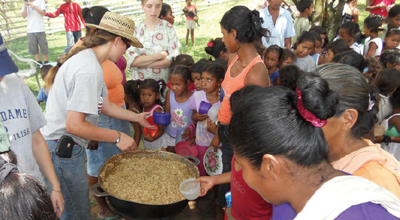New Hope Among Forgotten Tribe
Pastor Charles Bennett has only seen two places he’d consider “overly ripe” for revival. One of them is Papua New Guinea, one of the world’s least explored countries culturally and geographically. But the other is home to an obscure tribe of Indians in Nicaragua.
The Miskito Indians occupy about 120 villages along the Rio Coca River bordering Nicaragua and Honduras. These witchcraft-practicing people live in a secluded area, which is just one of the reasons missionaries overlook them.
J. David Ford first visited the country with Bennett, pastor of Joy Fellowship church in Hopewell, Va. God touched Ford’s heart for the Nicaraguan people and he made plans to start a ministry there. But he stumbled upon the Indian tribe of about 71,000 by accident. Ford was moved by this forgotten group riddled with extreme poverty, hunger and spiritual darkness—and he felt called to share the love of Christ with them.
“We can be involved in the transformation of an entire people group,” says Ford, whose father started a ministry in 1933 that spread to 45 nations.
Ford launched New Hope Children’s Foundation in Nicaragua in 2004, which operates three children’s homes, 60 feeding stations and a school that provides more than 300 children a free Christian education. But the ministry has extended its outreach to the Miskito Indians, rescuing children who have no parents or are suffering from sexual abuse, hunger and other injustices.
“Where his ministry is shining the most is through the orphanage,” Bennett says. “Kids who were once scared and hid their faces are now outgoing, vibrant, interactive and growing in the grace of God. The love of God and fruit of the Spirit has grown in their lives.”
As part of New Hope’s strategy, each child hears the gospel of Jesus Christ—and their more guarded parents in turn hear it through their children. Though Ford doesn’t know exactly how many Miskitos have come to the Lord, he’s already seen fruit and expects to see a great harvest in the years ahead.
Ford and Bennett had a radio tower built in Kisalaya, a town close to the Indians, and they believe it will be the most effective evangelism tool. Most of the 120 villages can only be reached by boat, and resources are costly in that area. Ford says one trip up or down the river can cost more than $800.
“We believe the radio could be a routing point,” Bennett says. “We may not be able to go to a particular village more than once a year, but with radio we can disciple these villages every day.”
Beyond the fledgling radio ministry, New Hope is believing for funds to finish up a brand new home that will hold 24 Miskito orphans. The team also plans to teach the Miskito Indians how to farm and plant crops on about 150 acres of land the village of Kisalaya donated.
Although a church building in a Miskito Indian village looks much different than what Americans are used to—it often resembles a hog shed—Ford says Christians there are on fire for the Lord and sharing their faith with their fellow Miskitos.
“There’s lots of singing, worship, beating on turtle shells,” Ford explains. “They’re very fervent and they have lots of faith. They’re giving it everything they’ve got.














































